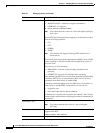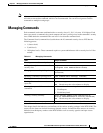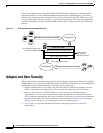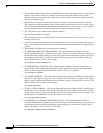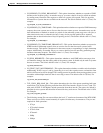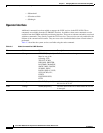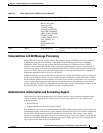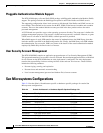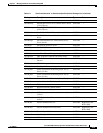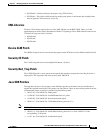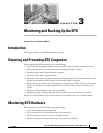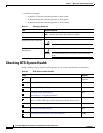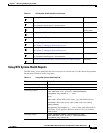
2-12
Cisco BTS 10200 Softswitch Operations and Maintenance Guide, Release 6.0.x
OL-16000-07
Chapter 2 Managing BTS Users and Commands Using EMS
Sun Microsystems Configurations
Pluggable Authentication Module Support
The BTS 10200 deploys a Secure Shell (SSH) package with Pluggable Authentication Module (PAM)
support. The package includes the PAM support required to utilize the Radius and LDAP servers.
The supporting configuration allows local accounts to fall through if the Radius and LDAP servers are
not available. These default local accounts for the BTS 10200 are the btsuser, btsadmin and secadmin
accounts. These are the standard default accounts provided in the base product and use the native
password management.
A UNIX-based user provides access to the operating system on all nodes. The oamp user is defined for
package management purposes. The account is locked and no password is available. However, to grant
UNIX access to all nodes of the BTS 10200, a default password is provided.
When PAM support is used, SSH transfers the control of authentication to the PAM library, that then
loads the modules specified in the PAM configuration file. Finally, the PAM library tells SSH whether
the authentication was successful. SSH is not aware of the details of the actual authentication method
employed by PAM. Only the final result is of interest.
User Security Account Management
The BTS 10200 EMS contains an application program known as User Security Management (USM).
This program determines if an account is local or off-board. Password management facilities are disabled
for all accounts on the BTS 10200 when an AAA deployment is configured. The AAA deployment
transfers the responsibility for these existing facilities to the end-user AAA servers. These facilities
include the following attributes:
• Password aging, warning, and expiration
• Password reset and automatic account locking
• Local account management (password and shadow files) for new accounts
Sun Microsystems Configurations
Table 2-4 lists the Solaris 10 architecture-specific or hardware specific packages for certain Sun
Microsystems configurations.
Table 2-4 Solaris Architectural- or Hardware-Specific Optional Package List
Package Description Type Status
SMEvplr SME platform links SYSTEM —
SMEvplu SME usr/platform links SYSTEM —
SUNWaudd Audio drivers SYSTEM —
SUNWauddx Audio drivers (64-bit) SYSTEM —
SUNWced Sun GigaSwift Ethernet Adapter (32-bit driver) SYSTEM —
SUNWcedx Sun GigaSwift Ethernet Adapter (64-bit driver) SYSTEM —
SUNWcg6 GX (cg6) device driver SYSTEM —
SUNWcg6x GX (cg6) device driver (64-bit) SYSTEM —
SUNWcsd Core Solaris devices SYSTEM —



